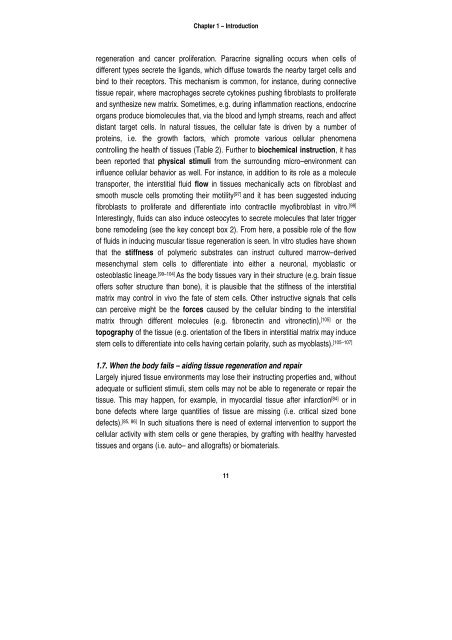Barbieri Thesis - BioMedical Materials program (BMM)
Barbieri Thesis - BioMedical Materials program (BMM)
Barbieri Thesis - BioMedical Materials program (BMM)
Create successful ePaper yourself
Turn your PDF publications into a flip-book with our unique Google optimized e-Paper software.
Chapter 1 – Introduction<br />
regeneration and cancer proliferation. Paracrine signalling occurs when cells of<br />
different types secrete the ligands, which diffuse towards the nearby target cells and<br />
bind to their receptors. This mechanism is common, for instance, during connective<br />
tissue repair, where macrophages secrete cytokines pushing fibroblasts to proliferate<br />
and synthesize new matrix. Sometimes, e.g. during inflammation reactions, endocrine<br />
organs produce biomolecules that, via the blood and lymph streams, reach and affect<br />
distant target cells. In natural tissues, the cellular fate is driven by a number of<br />
proteins, i.e. the growth factors, which promote various cellular phenomena<br />
controlling the health of tissues (Table 2). Further to biochemical instruction, it has<br />
been reported that physical stimuli from the surrounding micro–environment can<br />
influence cellular behavior as well. For instance, in addition to its role as a molecule<br />
transporter, the interstitial fluid flow in tissues mechanically acts on fibroblast and<br />
smooth muscle cells promoting their motility [97] and it has been suggested inducing<br />
fibroblasts to proliferate and differentiate into contractile myofibroblast in vitro. [98]<br />
Interestingly, fluids can also induce osteocytes to secrete molecules that later trigger<br />
bone remodeling (see the key concept box 2). From here, a possible role of the flow<br />
of fluids in inducing muscular tissue regeneration is seen. In vitro studies have shown<br />
that the stiffness of polymeric substrates can instruct cultured marrow–derived<br />
mesenchymal stem cells to differentiate into either a neuronal, myoblastic or<br />
osteoblastic lineage. [99–104] As the body tissues vary in their structure (e.g. brain tissue<br />
offers softer structure than bone), it is plausible that the stiffness of the interstitial<br />
matrix may control in vivo the fate of stem cells. Other instructive signals that cells<br />
can perceive might be the forces caused by the cellular binding to the interstitial<br />
matrix through different molecules (e.g. fibronectin and vitronectin), [105] or the<br />
topography of the tissue (e.g. orientation of the fibers in interstitial matrix may induce<br />
stem cells to differentiate into cells having certain polarity, such as myoblasts). [105–107]<br />
1.7. When the body fails – aiding tissue regeneration and repair<br />
Largely injured tissue environments may lose their instructing properties and, without<br />
adequate or sufficient stimuli, stem cells may not be able to regenerate or repair the<br />
tissue. This may happen, for example, in myocardial tissue after infarction [84] or in<br />
bone defects where large quantities of tissue are missing (i.e. critical sized bone<br />
defects). [85, 86] In such situations there is need of external intervention to support the<br />
cellular activity with stem cells or gene therapies, by grafting with healthy harvested<br />
tissues and organs (i.e. auto– and allografts) or biomaterials.<br />
11





